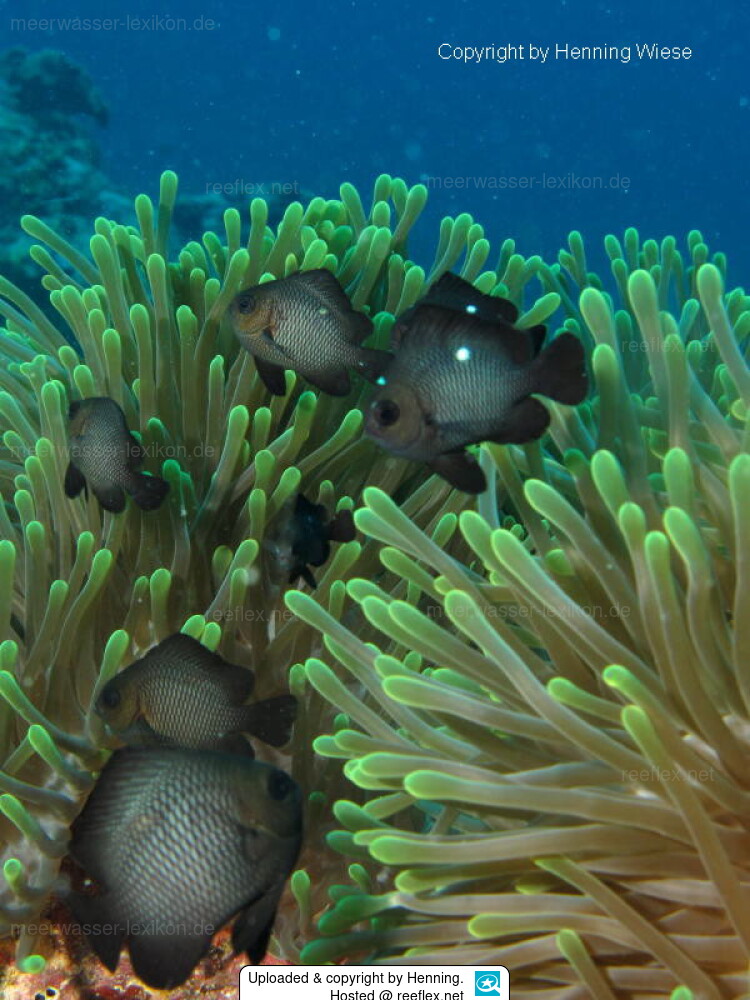Info
(Rüppell, 1829)
Known to be a beginners fish. Very agressive, will attack any new fish. Only keep in pairs, not as swarm like sometimes quoted in literature.
Synonyms:
Dascyllus axillaris Smith, 1935
Dascyllus niger Bleeker, 1847
Dascyllus trimaculatum (Rüppell, 1829)
Dascyllus unicolor Bennett, 1831
Pomacentrus nuchalis Anonymous [Bennett], 1830
Pomacentrus trimaculatus Rüppell, 1829
Sparus nigricans Gronow, 1854
Classification: Biota > Animalia (Kingdom) > Chordata (Phylum) > Vertebrata (Subphylum) > Gnathostomata (Superclass) > Pisces (Superclass) > Actinopterygii (Class) > Perciformes (Order) > Pomacentridae (Family) > Dascyllus (Genus) > Dascyllus trimaculatus (Species)
am 11.12.19#7
Ich halte 2 von diesen Preußen in einem 200 l Becken mit 2 Percula, einem chrysiptera parasema, 2 Pyjama Kardinalbarschen, 2 Chromis viridis und einer Sechspunkt Schläfergrundel sowie eine Gelbschwanz Demoisellen. Letzterer ist der Dominante. Ein Preuße kuschelt ständig mit meiner Rotfußanemone.
Es ist viel Bewegung im Becken, aber alle vertragen sich prächtig. Die Besatzung ist jetzt 3 Wochen an Bord. Die Dascyllus sind als letzte dazugekommen.
Demnächst kommt noch eine Kupferanemone hinzu, damit auch die „Nemos“ ihre Anemone haben.
am 10.03.15#6
Hallo
Ich habe dieses Tier eigentlich nur für ein paar Wochen in meinen Riff untergebracht da der Vorbesitzer ihn wegen Pilzinfektion töten wollte
Mein becken fasste zu diesem zeitpunkt ca 300liter
inzwischen ist er wieder gesund dank UVC Klärer und ich kann nur sagen Achtung!!!!!
Ich habe inzwischen schon Angst in das Becken zu greifen da er mich schon mehrmals stark eingebissen hat, sodass ich geblutet habe
Er ist wirklich sehr Aggressiv und attackiert wirklich alles was neu ist bzw in seine Nähe kommt
das Tier ist inzwischen nach ca 4 Wochen umgezogen in ein 3000 Liter Becken
Fazit: Ist wirklich ein Fisch der so gut wie alles Frisst und wirklich sehr einfach zu halten ist
jedoch muss man aufpassen beim reinigen und genügend Futter zur verfügung stellen
am 23.06.11#5
Der wohl aggressivste unter den Aquariumfischen.
Ich habe eine Woche gebraucht um ihn mit einer Fischfalle einzufangen.
Er schwimmt jetzt im Kölle-Zoo Frankfurt in einem Becken mit LS und anderen Aggresivos.
Für die Toilette tat er mir dann doch Leid.
Absolut nicht zu empfehlen, greift alles an was neu ins Becken kommt.







 Henning
Henning





































